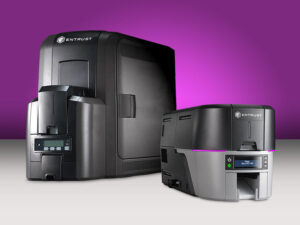New to ID card printers? Below are some definitions that can help you understand the lingo commonly used in printer settings, choosing printer features and when ordering supplies.
Printing Technologies
- Direct-to-Card (DTC) Printing – also called “dye-sublimation”, is the fastest, most affordable, and most common type of printing. In DTC printing, the card design is printed directly to the surface of the card, using heat and pressure, applied by the printer’s printhead. DTC printing uses “edge-to-edge” printing. DTC printers use a printhead that prints directly on the card. To avoid unnecessary damage to the printhead, it does not span the entire width or length of the card. As a result, there is a slight, barely visible blank border around the outer edges of the cards. In DTC printing, the printhead comes in direct contact with the card, providing opportunities for damage to the printhead. As a result, there is a higher chance of printhead damage with DTC printers.
- Retransfer Printing – short for “reverse transfer printing” and sometimes called “reverse image printing”, is a method where the card design is first printed onto a clear film, called retransfer film. Then, using heat and pressure, the film is fused to the card surface. Unlike DTC printing, the printhead does not come in contact with the surface of the card. With retransfer printers, there is limited opportunity for the printhead to be damaged, since it does not come into contact with the card surface.
Printer Ribbon Types
- K or KO Ribbon – K simply means “black”. Therefore, a K ribbon only prints black images. KO means black with overlay. The majority of ribbons come with an overlay (O) panel to provide additional protection from abrasion.
- YMCK or YMCKO – YMCK ribbons are color ribbons. Card printers use subtractive color mixing, which allows them to create millions of colors. All of those colors are created from the mixing of yellow, magenta, cyan, and black – or Y, M, C, and K. Again, O just means there is an additional overlay panel. So YMCKO means full-color with an overlay panel.
- YMCKK or YMCKOK – YMCKK ribbons are double-sided ribbons. They use the same yellow, magenta, cyan, and black to print in full-color on the front, and have an additional black (K) panel to print in black and white on the back of the card. Once again, the O means that there is a protective overlay panel for the front (color) side of the card.
ID Card Technologies
- CR8030 / CR80 30mil – Also known as credit card-sized cards, since they are the size of a standard credit card. CR80 cards measure 2.13″ x 3.38″ (54 mm x 86 mm). The 30mil refers to the thickness of the cards – 0.030″ (0.76 mm). CR8030 is the standard size of an ID card, and is compatible with almost every ID card printer.
- Contact Smart Cards – Contact smart cards are physically inserted into a smart card reader, and make contact with the reader (ex. a chip debit or credit card).
- Contactless Smart Cards – Contactless smart cards take advantage of an antenna that is embedded into the inside of the card. As a result, the card can communicate with the ready, without any physical contact (ex. Interac Flash).
- High Coercivity (HiCo) vs Low Coercivity (LoCo) – Magnetic stripe cards come in 2 different formats; high and low coercivity (or HiCo and LoCo). Coercivity is the resistance of a magnetic material to become demagnetized or change its magnetization, and it is measured in Oerstead (Oe) units. HiCo mag stripes commonly run at 2,750 Oe, and can run up to 4,000 Oe, whereas LoCo cards only run at 300 Oe. Therefore, HiCo cards are harder to erase, take more energy to record, and are the best option for a frequently used card like a credit card or access control card. Whereas LoCo cards are the perfect option for cards that are used less frequently or where information on the card is being changed often, such as gift cards and hotel room keys.
Other Common Terms
- Printer Drivers – A piece of software that is installed on a computer that converts data into a format that the printer can understand. Drivers allow printers to print from a variety of file types and applications, and are specific to computer operating systems and printers.
- USB 2.0 Connectivity – Standard USB 2.0 connection, to connect a card printer to a single desktop or laptop computer.
- Ethernet Connectivity – Wired Ethernet connection to connect a card printer to an organization’s network. This allows any computer on the network (with the proper drivers installed) to print on from the card printer. Many organizations’ paper printers work via network connectivity.
ID Card Printing Solutions from the ISG
We hope that these term definitions assist you with learning the basics for ID card printers.
The ISG offers the best photo ID card issuance solutions in the industry. From the blank cards to card printers, cameras and software, to readers, ID accessories and much more. We can provide you with everything you need to issue employee, visitor, student and patient ID cards.
Contact us today to learn more about ID card printers and other solutions from your local ISG dealer.
The original article was written by Justin Smith for ID Experts.

